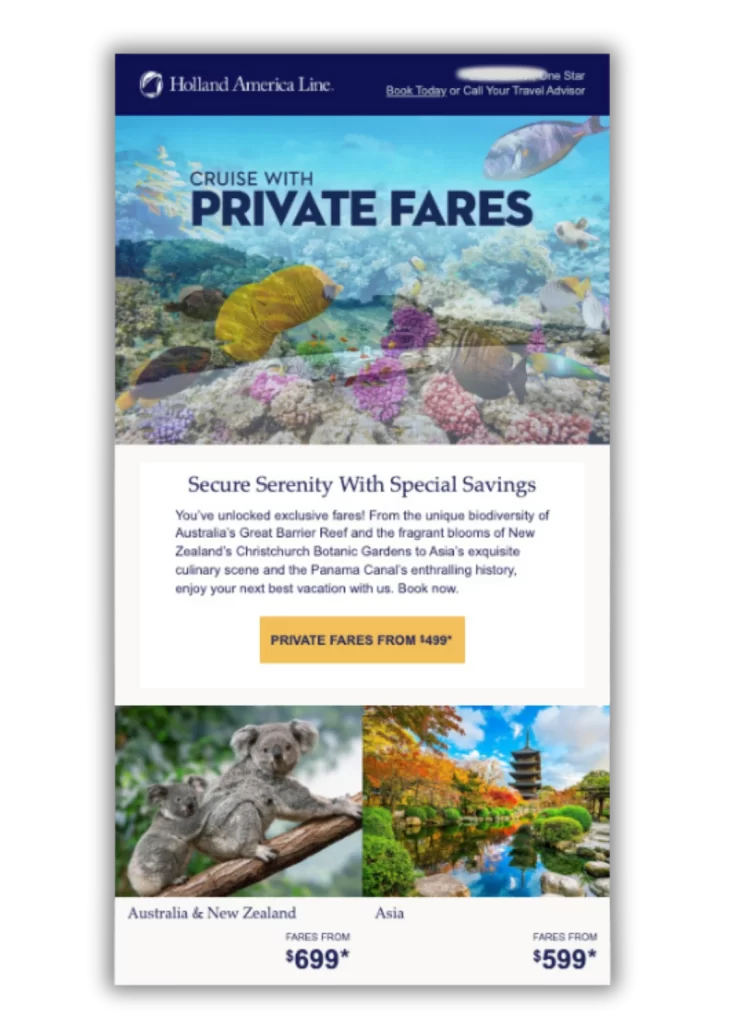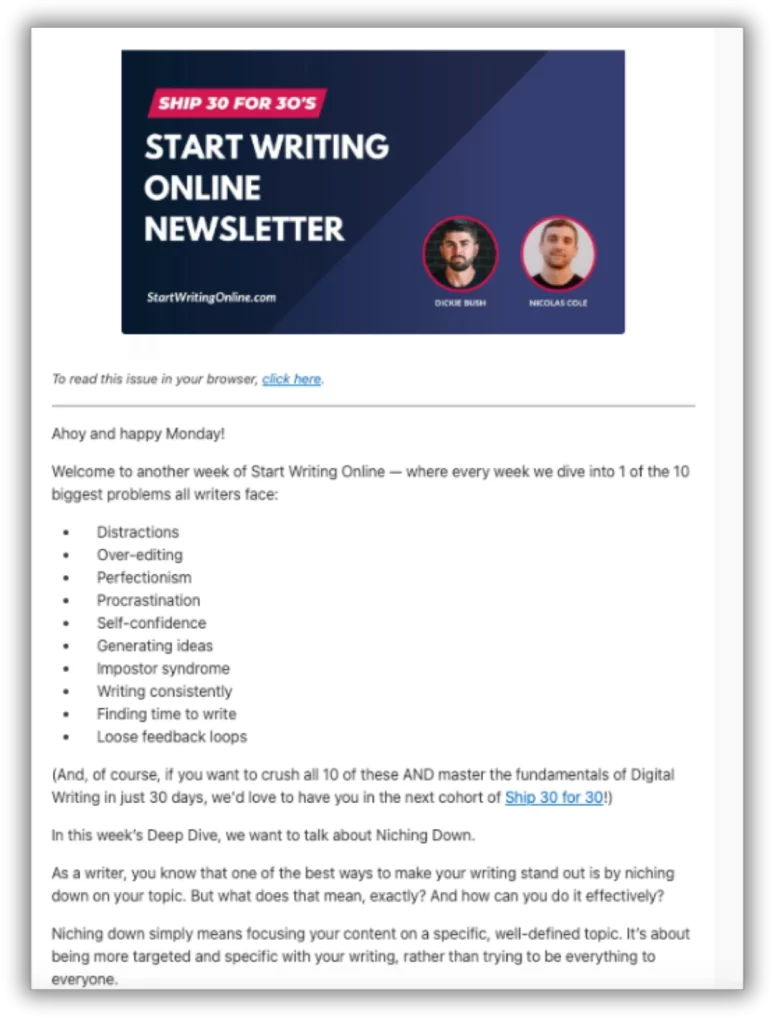Whenever a customer gives you their email address, you’ve earned their trust, and they want to know more about you. But too often, we don’t utilize email lists to their potential, leading to fewer sales and opportunities.
Businesses deal with different types of prospects within the buyer’s journey. Every lead is unique, and your messages should be tailored to them. That’s where email nurturing comes in.
When you implement an effective email nurturing strategy, you create more loyal customers and increase conversions from the leads you’ve invested in.
In this article, we’ll define email nurturing, how it works, and its benefits, along with best practices and examples.
Table of contents
- What is an email nurture campaign?
- How email nurture campaigns work
- Benefits of a nurture campaign
- Best practices for email nurture campaigns
- How to write a lead nurture email
- Email lead nurture campaign examples and templates
What is an email nurture campaign?
An email nurturing campaign leads subscribers down the buyer’s journey so they make a purchase or make a specific action. It is a series of highly relevant, targeted emails based on the subscriber’s actions, behavior, and needs.
For example, imagine if someone signs up for a contest to win tickets to a performance art theater. They opt-in to receive more emails when they sign up. The contestant might not win, but now they routinely receive emails.

Here’s an example of a contest used for lead generation.
Each email offers a unique offering only available to the list, updates on upcoming shows and events, behind-the-scenes specials, and highly relevant content. As the theater builds and nurtures the relationship (and collects data on behavior), subscribers find a show they’re interested in. By now, they trust the theater and have a relationship with it, and it’s an easy choice– targeted subscribers immediately click the button to purchase.
Email nurturing campaigns are useful for many scenarios:
- Turning leads into customers
- Building trust
- Motivating hesitant buyers to action
- Testing customer behavior with different interests and messages
- Re-engaging an inactive or underperforming email list
- Cross-selling complementary products and services
- Increasing sales
- High-ticket offerings
🛑 Fuel your email nurture campaigns with this big book of small business email templates, subject lines, and more!
How email nurture campaigns work
Email nurturing campaigns facilitate the customer throughout their journey.
Successful campaigns focus on the sales funnel:
- Awareness: Your target audience learns about your brand through a lead magnet, advertisement, or other marketing channel.
- Interest: Target audience members subscribe to your email list to learn more about you and your product.
- Consideration: Subscribers are nurtured throughout the lifetime of your email relationship, as brands address each need they have based on their behaviors. Subscribers feel the need to make a decision.
- Decision: You present the offer, and your subscribers can choose to purchase or act, leading to conversions.
- Loyalty: Your brand continues to develop its relationships, leading customers to more offers and building long-term commitment.
Email nurturing campaigns can only be effective based on how well you can identify customers in the journey outlined above. That’s why segmenting your audiences is critical for a successful nurturing campaign.
There are several steps brands can take to help strategize their email nurture strategy.
Determine how to capture leads
Businesses should understand the context of their email list.
One customer who signed up for a free ebook on buying the highest-grade tires will look a lot different than one who signed up after reading a blog post on tire maintenance for a longer life. The first buyer intends to buy premium goods, while the other wants to get the most out of what they already purchased.

People who subscribe to get a discount belong on your “value shoppers” email list.
When subscribers receive emails, brands should have the information and infrastructure to provide relevant information and communication.
Note where prospects and customers are in your buyer’s journey
Has the person purchased from you before? Are they purchasing introductory products? Is your newsletter sign-up the only action the subscriber has taken so far? These are the types of behavior data points you want to collect. Once you know where each group is on their buyer’s journey, you can create campaigns for each stage.
List your email marketing KPIs
Every email list has opportunities to improve. For you, it might be an email open rate, a click-through rate, or another key performance indicator. Maybe you already have a great, healthy, engaged list, but you can’t increase conversions. Once you establish your goals, you can develop the exact nurturing campaigns to hit the challenge face-on.
Optimize for target audience segments
All these questions lead to organizing your subscribers based on their behaviors and needs. By segmenting your audience, you can nurture them with accuracy.
Imagine you are at home, and there are two struggling houseplants. One is near a window inside, and the other is on the front porch. Both will have different needs to feel better. The one at home might be overwatered, while the one outside might get too much sun. They require separate solutions. That’s what nurturing is all about–caring for someone through highly relevant solutions.

You can segment nurture emails by product interest. If someone loves their cold brew, make sure they get the deal when a new flavor comes out.
Find out the pain points, hesitations, and journey each segment of your audience belongs to.
Send the right amount of relevant emails
Finally, ask yourself if you are consistent with your emails and whether you should send more (or fewer) than your current strategy. Each email should have a purpose. You want to offer a branded, consistent quality with your email campaign, much like the experience a brand wants people to feel when customers visit its site or store.
Benefits of a nurture campaign
Nurture campaigns primarily guide leads to become customers. But they also improve results at other stages of your customer’s journey.
Increased conversions
Healthy email nurturing campaigns drive towards one significant action. Brands recognize the buyer’s journey and want to help the customer. When done right, it increases conversions. Brands use subscriber behavior data, context, relationship-building emails, and more to create a well-tuned symphony driving toward the ultimate goal.

Granscape puts a call-to-action button at the center of their email.
Nurture emails with a strong call-to-action button are excellent drivers of conversions.
Improved brand loyalty
As brands provide value with nurture campaigns, subscribers become customers and eventually ambassadors. They become passionate about your product or service and align themselves with your big-picture vision. Better brand loyalty leads to more sales, a longer customer lifetime, word-of-mouth marketing, and many more opportunities.
More efficient marketing strategy
Email nurturing strengthens your entire email list and customer relationships. When it’s time to start a new campaign or launch a new product, subscribers are more likely to respond and take action. You’ve invested in them, and they believe in your products and the value you promise.
Behavioral data points for better connections
Email nurturing campaigns offer a treasure trove of information. For example, if subscribers sign up through a lead magnet, you can study their behavior and engagement afterward. Do they immediately read new emails? Or are there certain emails they are more attracted to? You can study each segmentation based on how you acquired their contact information and why they signed up.

Email nurture campaigns provide you with valuable zero and first-party data.
Brand awareness
As you run a successful nurturing campaign, subscribers will likely share your emails and spread the word. For example, if you send valuable content in your campaign, subscribers want their friends with similar interests to experience it, too.
As your emails become more popular and respected within your community, people will take notice. Your email strategy has the potential to grow beyond lead magnets and become a respected industry source for your target audience. This, in turn, increases your reach and awareness throughout the market.
Best practices for email nurture campaigns
By now, we’ve gone over many critical elements of email nurture campaigns. You can use this list below to create effective parameters in your marketing strategy:
Segment your email nurture list
Brands should segment their audience to offer the right emails at the appropriate time. An easy way to start is by segmenting by each stage in the sales funnel. You can also create groups based on how you acquired the email address and future behavior, like specific clicks and actions. That’s why having the right email system that talks to your CRM and other platforms is vital for healthy campaigns.
Personalize nurture emails
Subscribers respond more when their name is included in the email. But personalization goes beyond first names. It’s also about specific needs and how you address the person. The better you connect with the reader, the more likely you get a positive response. Using a personal sender name instead of the company or sending a message highly targeted to the subscriber’s specific action will improve your results.

Celebrate events like birthdays to give your nurture emails that personal touch.
Time your emails for better results
If someone is interested in what you have to offer but hesitant, sending them a direct sales email might not do the trick (yet). That’s why knowing who you’re talking to and how you can structure the campaign for maximum conversions is essential. Your email nurturing campaign can include automation and drip campaigns to space out how often you communicate to the person and about what.

Start new subscribers off with a welcome email like this one.
You can strategize by how much you’ve earned your customer’s permission to email. For example, if the subscriber signed up to receive an industry report you created, that’s a high-ticket magnet. If they’re happy with your report, you’ve earned social permission to send more frequent, strategic emails.
Now, suppose someone signed up because they visited your homepage. In that case, you want to send a thank you email but create a campaign that’s sensitive and highly relevant to the website visitor (think of when you meet someone at a coffee shop for the first time. You hand them your contact information and carefully build, aka nurture, the relationship).
Address pain points
Remember the main reason subscribers joined your email list. They have specific challenges and needs. Every person has a story with an obstacle, and you are the guide that can help them get a solution. Remind them in your emails.
Address each pain point and what subscribers can do to overcome them. Naturally tie in your products and services. Use these moments to tackle hesitations. Offer guarantees if people are hesitant to buy because they aren’t sure what they will get. If you offer an expensive home service, emphasize your free estimates–no strings attached. Address the target audience’s pain points for your solutions and the buyer’s hesitations.

Offer value
The more value you give away, the more customers want to spend with you. It’s also one of the best ways to nurture your email list quickly.
You can offer ebooks, seminars, courses, quizzes, samples, discounts, and several other forms of value. It builds trust and loyalty and allows you to send future emails throughout your campaign. As a subscriber, each person is part of your membership community– which changes the perceived value of your email list to something positive and exclusive.

Make sure to add some valuable information to keep people opening your nurture emails like Great Dog does.
Track progress
Throughout your campaign, measure behavior, positive and negative actions, and other data points you can collect. This first-party data is precious and some of the best sources of information you can get.
As you send each email, you can study its results and continually tweak and improve the campaign based on each test. Eventually, you’ll have an optimized campaign for all your audience segmentations for successful outcomes.
Ensure you have the proper email platform, CRM, and other tools to develop customer relationships throughout the campaign.
How to write a lead nurture email
Designing an email nurturing campaign is like telling a story. Your customer is the main character. You are the guide with a plan.
Use this narrative to develop your campaign. Start with the context, like how the person became a subscriber. Your introductory email can be a thank you message with immediate value and information to help the customer along their journey.
Then, address each pain point and stage until they make a purchase or desired action.
Once you’ve successfully led a series of emails that led to action, you can strategize on the next nurturing stage for your qualified customer.
As you write and design your emails, incorporate the following tips.
Keep it short and to the point
Most of the time, you want to write an email with one goal, as short as possible. The more options and different elements you include, the more likely readers will get confused or overwhelmed with the text.

Keep the word count low and the most important information at the top of your nurture emails.
An exception to this is if you are selling something costly to readers who are already invested in the value you offer. They may want a fuller picture of the offering with information, testimonials, and more. Another exception might be that your email provides very focused informational value (it should be highly relevant and clear, and each sentence should move the reader to the next).
Email designs are a great way to keep the message concise. You can include a visually stimulating graphic with microcopy that communicates your message.
Make it highly relevant
Subscribers won’t mind your emails if they solve their needs and offer value. If they are irrelevant, you’ll get a quick unsubscribe. Invest in the tools you need to understand your subscribers and design campaigns that address their unique needs and context.
Use a very clear CTA
Each email should have a goal. If one doesn’t, then you risk hurting your campaign.
Not every email should sell a product. An email nurturing campaign shouldn’t be all sales emails–they build to it.
Your goals can be straightforward. You want the person to learn something or click on a video. Or, you want them to download a resource. These are all effective steps to elicit action, earn trust, and measure their behavior– all to boost your conversions with a later email.
No matter what step you want a lead to take, make sure it’s clearly presented in a can’t-miss call to action.

Write a clear CTA and design it to stand out in each email.
🚨 Subject lines are one of the most important components of any marketing email. Pull winning options from this big list of compelling and conversion-boosting subject lines.
Email lead nurturing campaign examples and templates
There are many types of emails in a lead nurturing campaign. You can start today with some of the most common.
Introductory emails
This is the most crucial email of your nurture campaign. It’s the automatic response after signing up and the first impression you’ll give to your prospects.
The introduction email should have the following:
- Context: You address the subscriber knowing why they signed up
- Relevance: You know who you are talking to and what they need
- Value: You offer something immediately
- A call to action: You provide a step the subscriber can take if they want to learn more
- Expectation: You communicate your email plans like what to expect, how often you will send them, and more
In most cases, a well-designed email with short content will be the most effective.
The email should look like this:
- A thank you message
- Pain points that the customer feels and how you can help
- Immediate value like an article, downloadable resource, quiz, or sample
- A message about your future emails
Personal emails show significant results, and you can use a template like this to start:
Hi [First Name],
Thanks for signing up to [Brand Name].
We get what you’re going through, like [Pain Point #1], [Paint Point #2], and [Pain Point #3].
We help [Solution] so that [Benefit]. You can start now so you can [Additional Benefit] right away. Or, you can check out our [Free Value link] to see for yourself.
In the meantime, we’ll send you future goodies and valuable information. If you have any questions, please contact me personally.
[Sender]
The Morning Brew, a daily newsletter, redirects subscribers to their introductory message after signup. This is another excellent example of an introduction that thanks the subscriber, gives them value, and provides an idea of what to expect.

Morning Brew adds a lot of value to their introduction email.
Promotional emails
You can also send promotional emails to nurture subscribers. Brands should carefully design them for relevancy and a subscriber benefit (like a special offer or discount).
The cruise line Holland America often shares special deals for cruises. It’s especially valuable for subscribers looking for pricing deals.

Holland America shows off its best fairs to its email subscribers.
Below, Fresh Market shares deals and prices with their email list. Notice they know their audience when they include a section answering common questions about organic offerings. This is a great email nurturing tactic by rewarding subscribers and encouraging them to purchase.

Fresh Market highlights savings in their promotional emails to entice people to buy.
Informative emails
Brands can also send emails to educate or provide valuable information. The email in itself is the value. Each informative email must be highly relevant and address a pain point for successful results.
This email from Ship 30 for 30, the online writing program, covers starting an online newsletter for those wanting to grow their personal brand. The email offers extensive information and value that readers can implement immediately.

Ship 30 for 30 educates its subscribers with information-packed emails.
Re-engagement emails
Sometimes, you’re dealing with a dead email list. Or you’ve noticed the audiences are too mixed to understand the context and their needs. That’s okay; it means you need to get it back into shape. You might lose some subscribers at first, but it just means you are qualifying your list.
A re-engagement email involves restating your value, how you can help, and what subscribers can expect from now on.
You can use a template like this:
Hi [First Name],
It’s been a while since we’ve connected. You signed up for our newsletter a while back, and we thank you for that. We know you signed up because of your need with [Pain Point], and we want to help.
So we’ve created a new vision for our newsletter. We want to [Value Proposition] so you can [Benefit of Solving Paint Point].
If you aren’t interested in receiving emails, click here to unsubscribe.
If you want value to help you conquer [Pain Point], then stay tuned.
In a few days, we’ll send a brand-new guide on [Pain Point Solution] right to your inbox.
Talk to you soon,
[Sender]
[Brand Name]
Story emails
Another effective email for a nurturing campaign is telling a story. You can tell your brand story, but it’s always better to incorporate the customer as the hero.

Uncommon Goods tells the story of its brand in a welcome email.
One way to tell your story with your customer at the center is by sharing a specific customer’s journey. Find a loyal customer willing to help where you can build out a case study. Share their story within a few emails, each achieving a milestone and conquering a pain point. By the end of the story, you can invite your readers to experience the same results.
Pain point emails
Brands can start their nurturing campaign by addressing each pain point in their series. It’s vital to ensure that the pain points they pick are relevant to the audience and the biggest or most common. If the pain point is irrelevant to subscribers, they are less likely to open the following email in the series.
Pain point emails lead to direct sales at the end of their run. Use them wisely and address the reason subscribers are interested in you.
Resource emails
Brands can share popular resources already available to the public. For example, The Muse, a job search company, sends emails sharing relevant blog articles. The email notifies them of a list of relevant information, and if they’re interested in one of them, they can easily click it for immediate access.
Brands like The Muse also learn which topics are most popular by the clicks, which helps inform their blog strategy, value proposition, and understanding of customer needs.

An example of an email with resources from The Muse.
First-step emails
Sometimes, email nurturing campaigns start with action as the lead magnet. For example, Warby Parker lets you try on different glasses after taking a quiz. This is super effective because it leads to a subscriber’s immediate action and removes buyer hesitations (in Warby Parker’s case, the customer’s concern that they might not like how the glasses look on them).
Master Class, the education platform, has a similar strategy. When you visit their website, you can subscribe to their email list and get immediate samples of popular classes. Subscribers can check out the experience without having to purchase. They get immediate value, and as they enjoy the samples, Master Class continues to nurture them.

This email nurturing campaign from Masterclass already kicks off with immediate value. It allows prospects to start their buyer journey through active participation.
Master Class’s email introduces their product and then leads to the section below– a list of recommended courses with links leading to videos. Master Class can learn who clicks what, leading to possible future nurturing based on course interests.
The power of email nurturing campaigns
Many consumers block out the noise as social media, email inboxes, and irrelevant advertisements bombard them in every direction. But when they face an intentional, relevant email nurturing campaign, they start paying attention, and it makes all the difference.
Email nurturing and follow-up increase sales, brand loyalty, and reach and is an effective growth strategy.
Here are the types of email nurture campaigns that will build your lead nurture strategy:
- Promotional emails
- Informative emails
- Re-engagement emails
- Story emails
- Pain-point emails
- Resource emails
- First step emails






